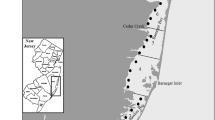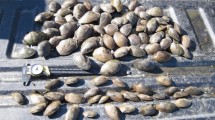Abstract
We surveyed the reproductive ecology of Cobitis minamorii minamorii in paddy fields and ditches. The spatial distribution of females in the spawning season differed from that in the non-spawning season, even in short ditches. Eggs were collected in both ditches and paddy fields, unlike an earlier study demonstrating that no eggs were collected in ditches. The frequency distributions of standard body lengths of males and females were unimodal and bimodal, respectively. The females with a large standard body length were expected to be gravid with higher probability in May.






Similar content being viewed by others
References
Connell JH (1961) The influence of interspecific competition and other factors on the distribution of the barnacle Chthamalus stellatus. Ecology 42:710–723
Hidaka K (1998) Biodiversity in paddy fields and its restoration. In: Ezaki Y, Tanaka T (eds) Conservation of aquatic environment - from perspective of a biological community. Asakura Shoten, Tokyo, pp 125–151
Kawamura T, Suzuki S, Usami K, Komuro M, Kawai N, Watanabe T, Yokoi H (2015) Habitat of Loach (Cobitis minamorii tokaiensis) in the Agricultural Drainage Channel. Res Bull Aichi Agric Res Ctr 47:115–118
Maehata M (2004) Aquatic ecotone of Lake Biwa - role of paddy fields for fishes -. Mizu 46:26–36
Minamori S (1950) Isolating mechanisms in the striated spinous loach, Cobstes taenia striata. J Sci Hiroshima Univ, Ser B Div 1, Zool 11:55–59
Minamori S (1954) Temperature adaptation of some local races of striated spinous loach. Jpn J Ecol 4:66–68
Ministry of the Environment Government of Japan (2020) Red list 2020, Ministry of the Environment, updated 27 May 2020. https://www.env.go.jp/press/107905.html. Accessed 24 March 2021
Morii K, Takakura KI (2018) Age class structure of spawning populations of two endangered endemic striated spined loaches in Lake Biwa river system. Jpn J Environ Entomol Zool 29:135–141
Nakajima J (2012) Taxonomic study of the Cobitis striata complex (Cypriniformes, Cobitidae) in Japan. Zootaxa 3586:103–130
Nakajima J (2017) Loaches of Japan. Yama-kei Publishers, Tokyo
Nakata K, Miyatake Y, Kawai K, Kobayashi S, Ham SN, Saito M, Aoe H (2017) Habitat preference by the endangered bitterling fish Rhodeus atremius suigensis in an agricultural channel in southern Okayama, western Japan. Ecol Civil Eng 19:117–130
R Core Team (2018) R: a language and environment for statistical computing. R Foundation for Statistical Computing, Vienna, Austria. https://www.R-project.org/. Accessed 24 March 2021
Saitoh K (1990) Reproductive and habitat isolation between two populations of the striated spined loach. Environ Biol Fishes 28:237–248
Saitoh K (1993) Smaller race and the large race of the striated spined loach are threatened. Jpn J Ichthyol 40:394–397
Saitoh K (2005) Cobitis striata species complex. In: Katano K, Mori S (eds) The present and future of endangered freshwater fishes: scenario of fruitful conservation. Shinzansha, Tokyo, pp 186–192
Takakura K-I, Fujii S (2010) Reproductive interference and salinity tolerance differentiate habitat use between two alien cockleburs: Xanthium occidentale and X. italicum (Compositae). Plant Ecol 206:309–319
Taniguchi Y, Nakano S (2000) Condition-specific competition: implications for the altitudinal distribution of stream fishes. Ecology 81:2027–2039
Acknowledgments
We are deeply appreciative of N. Ichikawa for his advice about this study site. This study was partly supported by JSPS KAKENHI Grant Number KB17K07273 and KB19J23611. All surveys complied with the current laws of the country in which they were conducted.
Author information
Authors and Affiliations
Corresponding author
Additional information
Publisher's Note
Springer Nature remains neutral with regard to jurisdictional claims in published maps and institutional affiliations.
Supplementary Information
Below is the link to the electronic supplementary material.
About this article
Cite this article
Morii, K., Kitano, D., Kanai, R. et al. Reproductive habitat use, body-size structure and spawning season of Cobitis minamorii minamorii in paddy fields and ditches. Ichthyol Res 69, 182–188 (2022). https://doi.org/10.1007/s10228-021-00826-1
Received:
Revised:
Accepted:
Published:
Issue Date:
DOI: https://doi.org/10.1007/s10228-021-00826-1




